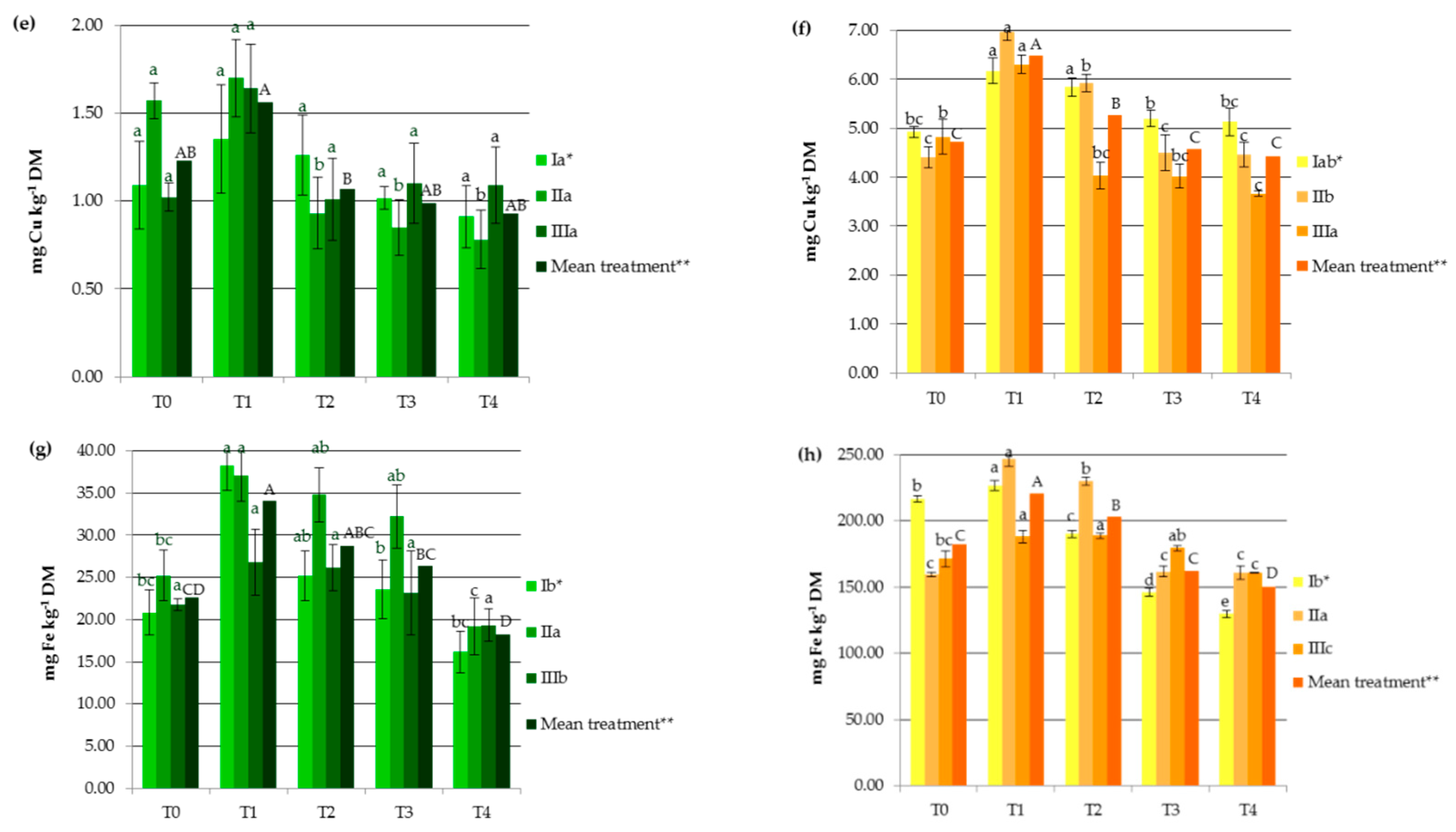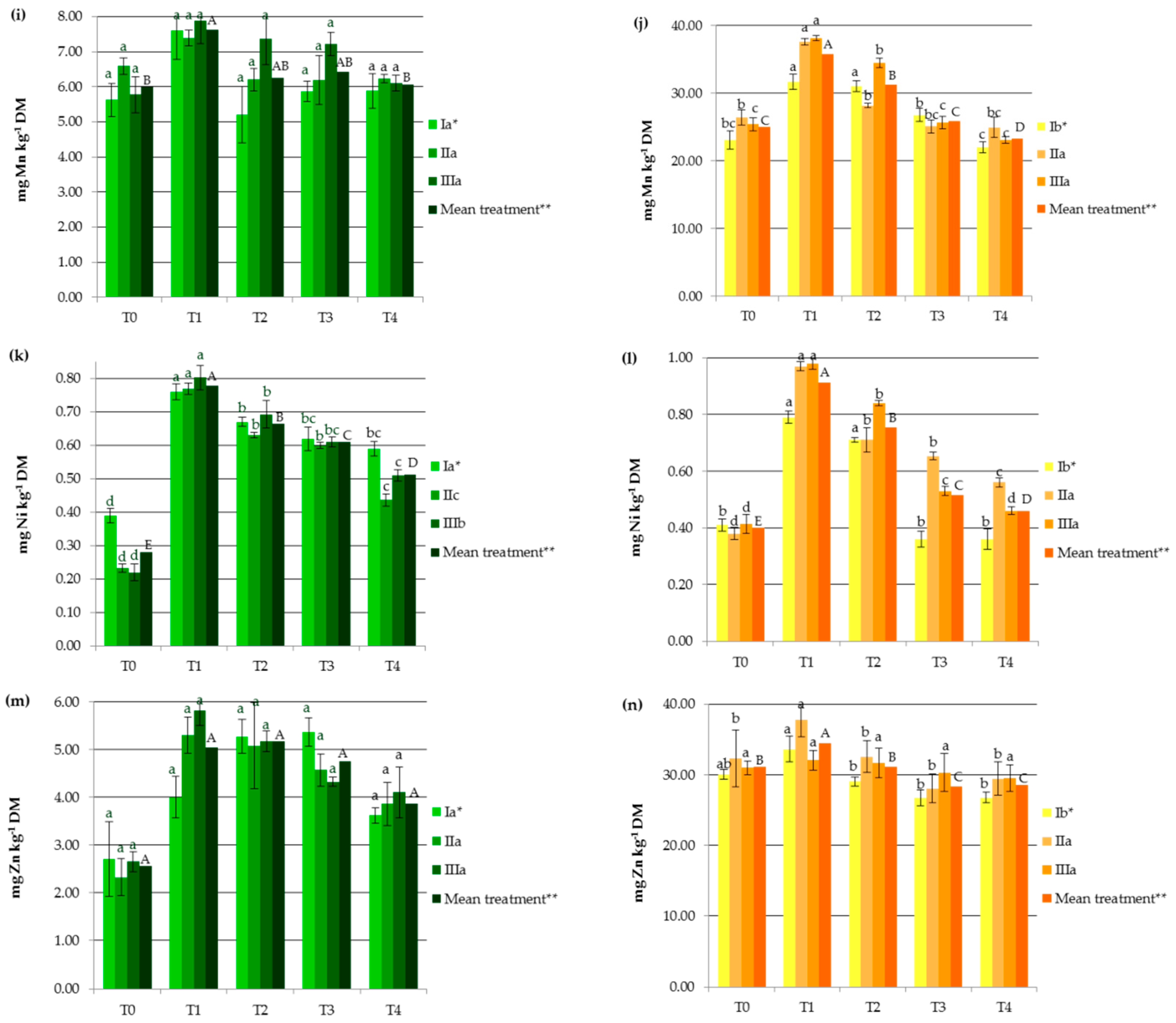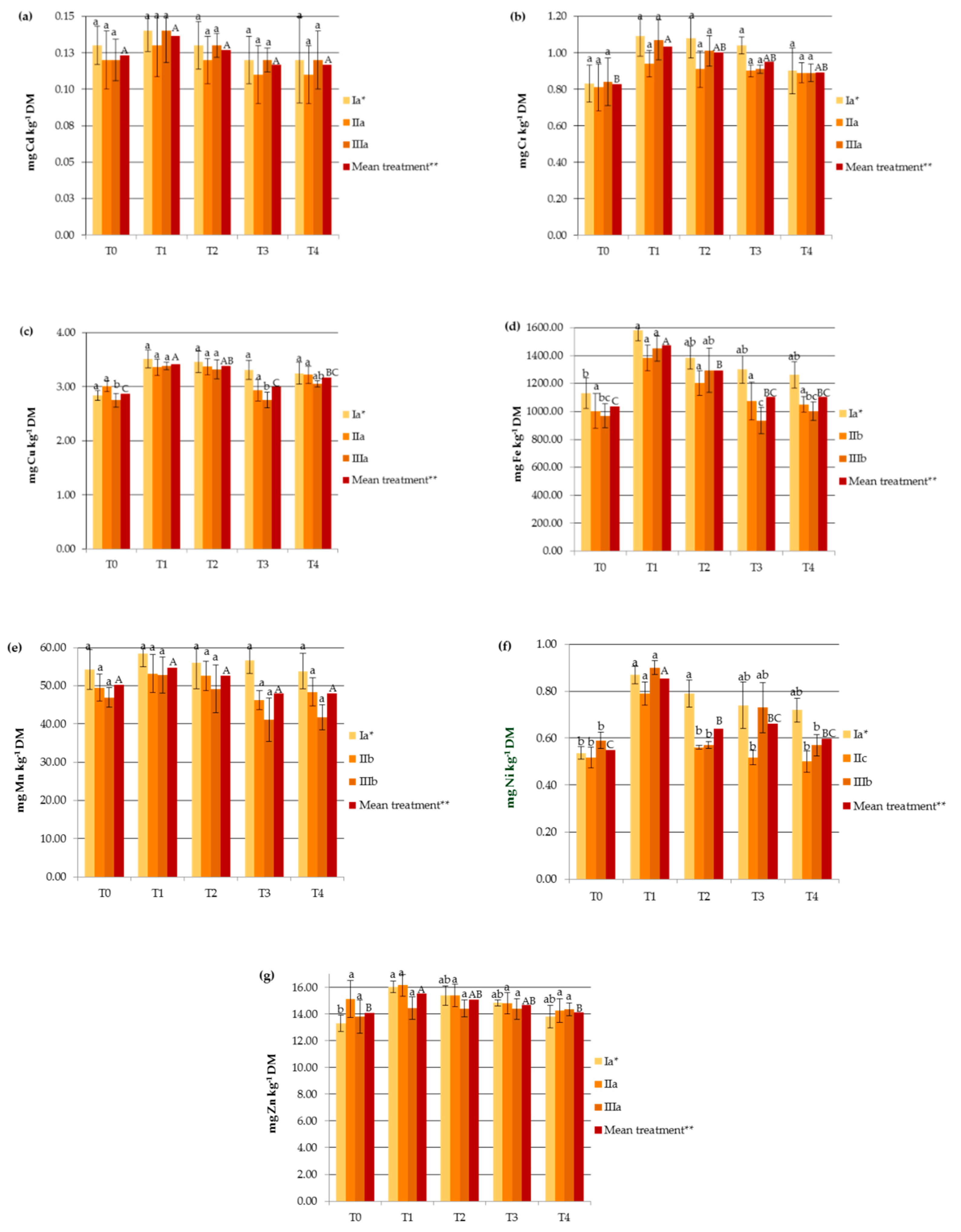Hemp-Based Phytoaccumulation of Heavy Metals from Municipal Sewage Sludge and Phosphogypsum Under Field Conditions
Abstract
:1. Introduction
2. Materials and Methods
3. Results and Discussion
4. Conclusions
Author Contributions
Funding
Conflicts of Interest
References
- Ahmad, R.; Tehsin, Z.; Tanvir, S.; Saeed, M.; Asad, A.; Shahzad, M.; Bilal, M.; Shah, M.M.; Khan, S.A. Phytoremediation potential of hemp (Cannabis sativa L.): Identification and characterization of heavy metals responsive genes. Clean Soil Air Water 2016, 44, 195–201. [Google Scholar] [CrossRef]
- Park, J.H.; Lamb, D.; Paneerselvam, P.; Choppala, G.; Bolan, N.; Chung, J.W. Role of organic amendments on enhanced bioremediation of heavy metal(loid) contaminated soils. J. Hazard. Mater. 2011, 185, 549–574. [Google Scholar] [CrossRef]
- Vardhan, K.H.; Kumar, P.S.; Panda, R.C. A review on heavy metal pollution, toxicity and remedial measures: Current trends and future perspectives. J. Mol. Liq. 2019, 290, 111197. [Google Scholar] [CrossRef]
- Vareda, J.P.; Valente, A.J.M.; Durãesa, L. Assessment of heavy metal pollution from anthropogenic activities and remediation strategies: A review. J. Environ. Manage. 2019, 246, 101–118. [Google Scholar] [CrossRef] [PubMed]
- Collivignarelli, M.C.; Abbà, A.; Frattarola, A.; Miino, M.C.; Padovani, S.; Katsoyiannis, I.; Torretta, V. Legislation for the reuse of biosolids on agricultural land in Europe: Overview. Sustainability 2019, 11, 6015. [Google Scholar] [CrossRef] [Green Version]
- Nissim, W.G.; Cincinelli, A.; Martellini, T.; Alvisi, L.; Palm, E.; Mancuso, S.; Azzarello, E. Phytoremediation of sewage sludge contaminated by trace elements and organic compounds. Environ. Res. 2018, 164, 356–366. [Google Scholar] [CrossRef]
- Seleiman, M.F.; Santanen, A.; Stoddard, F.L.; Mäkelä, P. Feedstock quality and growth of bioenergy crops fertilized with sewage sludge. Chemosphere 2012, 89, 1211–1217. [Google Scholar] [CrossRef] [PubMed]
- Laidlaw, W.S.; Arndt, S.K.; Huynh, T.T.; Gregory, D.; Baker, A.J.M. Phytoextraction of heavy metals by willows growing in biosolids under field conditions. J. Environ. Qual. 2012, 41, 134–143. [Google Scholar] [CrossRef]
- Narasimha, M.; Prasad, V.; De Campos Favas, P.J.; Vithanage, M.; Mohan, S.V. (Eds.) Industrial and Municipal Sludge: Emerging Concerns and Scope for Resource, 1st ed.; Butterworth-Heinemann, Elsevier Science: Oxford, UK, 2019; p. 856. [Google Scholar]
- Skowrońska, M.; Bielińska, E.J.; Szymański, K.; Futa, B.; Antonkiewicz, J.; Kolodziej, B. An integrated assessment of the long-term impact of municipal sewage sludge on the chemical and biological properties of soil. Catena 2020, 189, 104484. [Google Scholar] [CrossRef]
- Urra, J.; Alkorta, I.; Garbisu, C. Potential benefits and risks for soil health derived from the use of organic amendments in agriculture. Agronomy 2019, 9, 542. [Google Scholar] [CrossRef] [Green Version]
- Yang, G.-H.; Zhu, G.-Y.; Li, H.L.; Han, X.-M.; Li, J.-M.; Ma, Y.B. Accumulation and bioavailability of heavy metals in a soil-wheat/maize system with long-term sewage sludge amendments. J. Integr. Agric. 2018, 17, 1861–1870. [Google Scholar] [CrossRef] [Green Version]
- Chernysh, Y.; Balintova, M.; Plyatsuk, L.; Holub, M.; Demcak, S. The influence of phosphogypsum addition on phosphorus release in biochemical treatment of sewage sludge. Int. J. Environ. Res. Public Health 2018, 15, 1269. [Google Scholar] [CrossRef] [PubMed] [Green Version]
- Layr, K.; Hartlieb, P. Market analysis for urban mining of phosphogypsum. Berg Huettenmaenn Mon. 2019, 164, 245–249. [Google Scholar] [CrossRef] [Green Version]
- Saadaoui, E.; Ghazel, N.; Romdhane, C.B.; Massoudi, N. Phosphogypsum: Potential uses and problems—A review. J. Environ. Sci. 2017, 74, 558–567. [Google Scholar] [CrossRef]
- Hentati, O.; Abrantes, N.; Caetano, A.L.; Bouguerra, S.; Gonçalves, F.; Römbke, J.; Pereira, R. Phosphogypsum as a soil fertilizer: Ecotoxicity of amended soil and elutriates to bacteria, invertebrates, algae and plants. J. Hazard. Mater. 2015, 294, 80–89. [Google Scholar] [CrossRef]
- Antonkiewicz, J.; Kołodziej, B.; Bielińska, E.J. Phytoextraction of heavy metals from municipal sewage sludge by Rosa multiflora and Sida hermaphrodita. Int. J. Phytoremediat. 2017, 19, 309–318. [Google Scholar] [CrossRef]
- Bauddh, K.; Singh, B.; Korstad, J. (Eds.) Phytoremediation Potential of Bioenergy Plants; Springer: Singapore, 2017; p. 472. [Google Scholar]
- Chandra, R.; Kumar, V. Phytoextraction of heavy metals by potential native plants and their microscopic observation of root growing on stabilized distillery sludge as a prospective tool for in situ phytoremediation of industrial waste. Environ. Sci. Pollut. Res. 2017, 24, 2605–2619. [Google Scholar] [CrossRef]
- Vaverková, M.D.; Zloch, J.; Adamcová, D.; Radziemska, M.; Vyhnánek, T.; Elbl, J.; Trojan, V.; Winkler, J.; Dorđević, B.; Elbl, J.; et al. Landfill Leachate Effects on Germination and Seedling Growth of Hemp Cultivars (Cannabis sativa L.). Waste Biomass Valor. 2019, 10, 369–376. [Google Scholar]
- Adesina, I.; Bhowmik, A.; Sharma, H.; Shahbazi, A. A review on the current state of knowledge of growing conditions, agronomic soil health practices and utilities of hemp in the United States. Agriculture 2020, 10, 129. [Google Scholar] [CrossRef] [Green Version]
- Griga, M.; Bjelková, M. Flax (Linum usitatissimum L.) and hemp (Cannabis sativa L.) as fibre crops for phytoextraction of heavy metals. Biological, agro-technological and economical point of view. In Plant-Based Remediation Process; Gupta, D.K., Ed.; Springer: Heidelberg/Berlin, Germany, 2013; pp. 199–237. [Google Scholar]
- Galić, M.; Perčin, A.; Zgorelec, Ž.; Kisić, I. Evaluation of heavy metals accumulation potential of hemp (Cannabis sativa L.). J. Cent. Eur 2019, 20, 711. [Google Scholar]
- Girdhar, M.; Sharma, N.R.; Rehman, H.; Kumar, A.; Mohan, A. Comparative assessment for hyperaccumulatory and phytoremediation capability of three wild weeds. Biotech 2014, 4, 579–589. [Google Scholar] [CrossRef] [PubMed] [Green Version]
- Praspaliauskas, M.; Žaltauskaitė, J.; Pedišius, N.; Striūgas, N. Comprehensive evaluation of sewage sludge and sewage sludge char soil amendment impact on the industrial hemp growth performance and heavy metal accumulation. Ind. Crops Prod. 2020, 150, 112396. [Google Scholar] [CrossRef]
- Bioremediation and Bioeconomy; Prasad, M.N.V. (Ed.) Elsevier: Waltham, MA, USA, 2016; p. 730. [Google Scholar]
- Angelova, V.; Ivanova, R.; Delibaltova, V.; Ivanov, K. Bio-accumulation and distribution of heavy metals in fibre crops (flax, cotton and hemp). Ind. Crops Prod. 2004, 19, 197–205. [Google Scholar] [CrossRef]
- Regulation of the Minister of the Natural Environment on Municipal Sewage Sludge Dated 6 February 2015. J. Laws Pol. 2015, 257.
- European Council. Official Journal of the European Union 56; C 378; Publications Office of the EU: Brussels, Belgium, 2014; pp. 1–44.
- Jones, J.B., Jr.; Case, V.V. Sampling, Handling, and Analyzing Plant Tissue Samples, SSSA Book Series 3. In Soil Testing and Plant Analysis, 3rd ed.; Westerman, R.L., Ed.; Soil Science Society of America: Madison, WI, USA, 1990. [Google Scholar]
- Rinkis, G.Y. Methods of Accelerated Colorimetric Analysis of Trace Elements in Biological Objects; Academy of Sciences of Latvian SSR: Riga, Latvia, 1963. (in Russian) [Google Scholar]
- De Souza, S.C.R.; De Andrade, S.A.L.; De Souza, L.A.; Schiavinato, M.A. Lead tolerance and phytoremediation potential of Brazilian leguminous tree species at the seedling stage. J. Environ. Manag. 2012, 110, 299–307. [Google Scholar] [CrossRef]
- Mahmoud, E.; Abd El-Kader, N. Heavy metal immobilization in contaminated soils using phosphogypsum and rice straw compost. Land Degrad. Dev. 2015, 26, 819–824. [Google Scholar] [CrossRef]
- Petrová, Š.; Benešová, D.; Soudek, P.; Vanĕk, T. Enhancement of metal(loid)s phytoextraction by Cannabis sativa L. J. Food Agric. Environ. 2012, 10, 631–641. [Google Scholar]
- Caporale, A.G.; Violante, A. Chemical processes affecting the mobility of heavy metals and metalloids in soil environments. Curr. Pollut. Rep. 2016, 2, 15–27. [Google Scholar] [CrossRef] [Green Version]
- Fageria, V.D. Nutrient interactions in crop plants. J. Plant Nutr. 2001, 24, 1269–1290. [Google Scholar] [CrossRef]




| Treatment | cv. (cultivar) Białobrzeskie | cv. Tygra | cv. Beniko | |||
|---|---|---|---|---|---|---|
| Heavy Metal Balance g ha−1 | Bioconcentration Factor Straw/Inflorescences | Heavy Metal Balance g ha−1 | Bioconcentration Factor Straw/Inflorescences | Heavy Metal Balance g ha−1 | Bioconcentration Factor Straw/Inflorescences | |
| Cd | ||||||
| T0 | −0.94 | 0.54/0.97 | −1.19 | 0.67/1.42 | −0.93 | 0.69/1.33 |
| T1 | −0.65 | 1.05/1.45 | −0.54 | 1.31/1.44 | −1.19 | 1.31/2.00 |
| T2 | 0.24 | 1.00/1.31 | −0.71 | 1.39/1.33 | 0.12 | 1.21/1.74 |
| T3 | 2.17 | 1.00/1.33 | 0.95 | 1.45/1.36 | 1.40 | 1.25/1.47 |
| T4 | 4.85 | 0.75/1.17 | 3.96 | 1.36/1.21 | 4.63 | 1.08/1.22 |
| Cr | ||||||
| T0 | −105.07 | 10.09/11.16 | −120.02 | 10.60/15.94 | −71.66 | 7.82/12.33 |
| T1 | −112.79 | 8.79/14.30 | −111.38 | 11.47/21.72 | −108.41 | 9.03/17.42 |
| T2 | −84.98 | 8.25/10.42 | −121.90 | 9.54/21.10 | −81.27 | 9.72/15.01 |
| T3 | −69.07 | 7.92/9.75 | −124.41 | 9.18/20.62 | −110.12 | 10.16/16.27 |
| T4 | −55.82 | 8.48/10.89 | −63.81 | 8.16/18.30 | −50.66 | 9.80/15.39 |
| Cu | ||||||
| T0 | −18.46 | 0.38/1.73 | -25.06 | 0.52/1.47 | −13.97 | 0.37/1.75 |
| T1 | 341.23 | 0.39/1.76 | 339.25 | 0.51/2.08 | 339.61 | 0.49/1.86 |
| T2 | 345.37 | 0.36/1.69 | 345.44 | 0.28/1.76 | 355.95 | 0.30/1.21 |
| T3 | 352.05 | 0.31/1.57 | 349.92 | 0.29/1.54 | 351.02 | 0.40/1.46 |
| T4 | 355.98 | 0.28/1.58 | 358.27 | 0.24/1.39 | 360.42 | 0.36/1.20 |
| Fe | ||||||
| T0 | −510.62 | 0.02/0.19 | −537.73 | 0.03/0.16 | −358.54 | 0.02/0.18 |
| T1 | −171.61 | 0.02/0.14 | −70.93 | 0.03/0.18 | 165.62 | 0.02/0.13 |
| T2 | 355.44 | 0.02/0.14 | −37.33 | 0.03/0.19 | 480.70 | 0.02/0.15 |
| T3 | 1311.72 | 0.02/0.11 | 938.90 | 0.03/0.15 | 1235.20 | 0.02/0.19 |
| T4 | 2515.89 | 0.01/0.10 | 2386.74 | 0.02/0.15 | 2549.62 | 0.02/0.16 |
| Mn | ||||||
| T0 | −92.33 | 0.10/0.43 | −117.19 | 0.13/0.53 | −77.48 | 0.12/0.54 |
| T1 | 767.16 | 0.13/0.54 | 782.28 | 0.14/0.71 | 769.41 | 0.15/0.72 |
| T2 | 813.78 | 0.09/0.55 | 778.02 | 0.12/0.54 | 805.05 | 0.15/0.70 |
| T3 | 812.61 | 0.10/0.47 | 772.89 | 0.13/0.54 | 782.48 | 0.17/0.62 |
| T4 | 821.09 | 0.11/0.41 | 806.57 | 0.13/0.52 | 843.08 | 0.15/0.55 |
| Ni | ||||||
| T0 | −4.87 | 0.73/0.76 | −3.30 | 0.45/0.74 | −2.46 | 0.37/0.70 |
| T1 | 24.36 | 0.87/0.91 | 25.92 | 0.97/1.23 | 24.04 | 0.89/1.09 |
| T2 | 27.37 | 0.85/0.90 | 26.37 | 1.13/1.27 | 28.38 | 1.22/1.47 |
| T3 | 32.02 | 0.84/0.49 | 29.33 | 1.16/1.26 | 30.63 | 0.84/0.73 |
| T4 | 36.50 | 0.82/0.50 | 38.38 | 0.87/1.12 | 38.97 | 0.89/0.81 |
| Zn | ||||||
| T0 | −68.78 | 0.20/2.26 | −76.31 | 0.15/2.14 | −52.72 | 0.19/2.25 |
| T1 | 1320.84 | 0.25/2.10 | 1309.75 | 0.33/2.34 | 1310.11 | 0.40/2.22 |
| T2 | 1318.04 | 0.34/1.89 | 1288.99 | 0.33/2.12 | 1339.41 | 0.36/2.20 |
| T3 | 1328.20 | 0.36/1.80 | 1303.42 | 0.31/1.90 | 1332.21 | 0.30/2.11 |
| T4 | 1362.22 | 0.26/1.94 | 1348.57 | 0.27/2.07 | 1376.34 | 0.29/2.06 |
© 2020 by the authors. Licensee MDPI, Basel, Switzerland. This article is an open access article distributed under the terms and conditions of the Creative Commons Attribution (CC BY) license (http://creativecommons.org/licenses/by/4.0/).
Share and Cite
Zielonka, D.; Szulc, W.; Skowrońska, M.; Rutkowska, B.; Russel, S. Hemp-Based Phytoaccumulation of Heavy Metals from Municipal Sewage Sludge and Phosphogypsum Under Field Conditions. Agronomy 2020, 10, 907. https://doi.org/10.3390/agronomy10060907
Zielonka D, Szulc W, Skowrońska M, Rutkowska B, Russel S. Hemp-Based Phytoaccumulation of Heavy Metals from Municipal Sewage Sludge and Phosphogypsum Under Field Conditions. Agronomy. 2020; 10(6):907. https://doi.org/10.3390/agronomy10060907
Chicago/Turabian StyleZielonka, Dariusz, Wiesław Szulc, Monika Skowrońska, Beata Rutkowska, and Stefan Russel. 2020. "Hemp-Based Phytoaccumulation of Heavy Metals from Municipal Sewage Sludge and Phosphogypsum Under Field Conditions" Agronomy 10, no. 6: 907. https://doi.org/10.3390/agronomy10060907
APA StyleZielonka, D., Szulc, W., Skowrońska, M., Rutkowska, B., & Russel, S. (2020). Hemp-Based Phytoaccumulation of Heavy Metals from Municipal Sewage Sludge and Phosphogypsum Under Field Conditions. Agronomy, 10(6), 907. https://doi.org/10.3390/agronomy10060907






